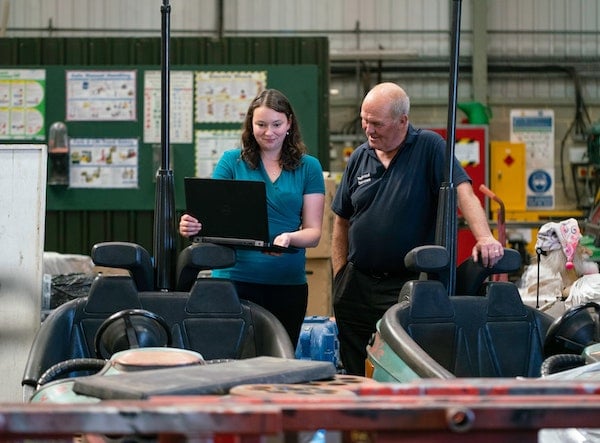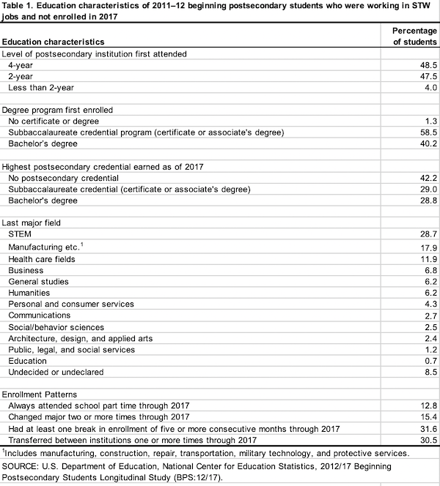Published on
The Benefits of Being a Skilled Technical Worker and the Sub-baccalaureate Paths These Workers Follow

The United States has a strong need for the skilled technical workforce (STW), a workforce that comprises workers in occupations that require significant science, technology, engineering and mathematics (STEM) expertise but not a bachelor’s degree. According to the National Science Board (NSB), the U.S. workforce currently has about 17 million STW workers and expects 3.4 million unfilled STW positions by 2022. [1] [2] Despite the need for STW workers, policy discussions about workers with STEM expertise have largely focused on supporting workers with bachelor’s, master’s and doctoral degrees, overlooking a strong potential workforce by brushing off those without a degree. [3]
A recent study by Chen and Rotermund investigated employment outcomes for college students who entered the STW after college. [4] This study revealed that when compared to the majority of their peers (i.e., students who worked in jobs that did not require significant technical skills), students in STW jobs fared better on a variety of dimensions, including salary, benefits, alignment between jobs and majors and job satisfaction. Given the growing need for STW workers and the benefits accrued by hiring these workers, it is important to understand these students’ educational pathways.
The analysis presented here is based on recently available national data from the 2012-17 Beginning Postsecondary Students Longitudinal Study (BPS:12/17), which followed a nationally representative sample of 2011–12 beginning postsecondary students over six years, gathering information about their demographic backgrounds, college experiences, postsecondary education completion and employment during and after college. Because full employment data were collected only for students employed in 2017, this analysis was restricted to the subset of BPS:12-17 cohort members who were working and no longer enrolled in school in 2017 (approximately six years after entering college). Despite positive employment outcomes and low credential requirements for entry into STW jobs, the analysis revealed that only 9% of students in this subset worked in STW jobs after college.
Less-than-four-year colleges and sub-baccalaureate programs were the two most common paths to STW careers. About 52% of students who pursued STW jobs after college (referred to as STW workers hereafter) began their postsecondary education at a two-year or less-than-two-year institution and 59% initially enrolled in a sub-baccalaureate program (table 1). Based on the highest postsecondary credential earned by 2017, 29% of STW workers had earned a certificate or an associate degree and 42% had attended college without earning any credential. These findings highlight the important role that community colleges and sub-baccalaureate programs play in filling the STW job pipeline.

Understanding which majors STW workers choose also provides insight into pathways that students interested in STW jobs could pursue. Among STW workers in the BPS:12-17 cohort, 29% chose a STEM major, 18% chose a major in manufacturing, construction, repair, transportation, military technology and protective services, and 12% chose a major in a health care field. These choices of major mapped on to the occupations of STW workers, [5] indicating that majors in these areas are good preparation for STW careers.
Among 2011–12 beginning students who were working in an STW job by 2017, noteworthy percentages followed enrollment patterns that are likely to have slowed their progress to postsecondary completion. For instance, 13% of these students always attended school part time, 15% changed their major two or more times, 32% interrupted their enrollment with a break of five or more months and 31% transferred schools.
There were also disparities in the demographic composition of students who entered STW jobs and those who worked in other jobs, with women and such racial/ethnic minority groups as African-Americans underrepresented in STW occupations. [4] It is important that all students have the opportunity to follow educational pathways to STW jobs because they offer such benefits as higher salaries (e.g., the median salary for STW workers in our sample was $35,900 compared to a median of $25,000 for nontechnical workers) and a higher likelihood of having health insurance and retirement benefits.
Thus far, empirical research on STW workers has been limited by a dearth of data. This study represents a first step toward betterunderstanding how students move from postsecondary education into STW jobs. Our analysis suggests that community colleges and associates and certificate programs play a vital role in preparing today’s students to be tomorrow’s skilled technical workers. Steering students toward two-year degrees with majors in STEM, manufacturing, construction, repair and health services will help ensure a robust STW pipeline. Creating programs to increase the number of women and minorities following pathways to STW jobs will also help ensure that all students have access to the promising future that an STW career can offer.
References:
[1] National Science Board (NSB). (2015). Revisiting the STEM Workforce: A Companion to Science and Engineering Indicators 2014. Arlington, VA: National Science Foundation. Retrieved November 11, 2019, fromhttps://www.nsf.gov/pubs/2015/nsb201510/nsb201510.pdf.
[2] National Science Board (NSB). (2020). State of U.S. Science & Engineering. Arlington, VA: National Science Foundation. Retrieved March 12, 2020, from https://ncses.nsf.gov/pubs/nsb20201.
[3] National Science Board (NSB). (2019). The Skilled Technical Workforce Crafting America’s Science & Engineering Enterprise. Arlington, VA: National Science Foundation. Retrieved November 11, 2019, from https://www.nsf.gov/nsb/publications/2019/nsb201923.pdf.
[4] Chen, X., and Rotermund, S. (in press). Entering the Skilled Technical Workforce After College (RTI Press Publication No. RB-RB-0024-2004). Research Triangle Park, NC: RTI Press. Retrieved May 1, 2020, from https://www.rti.org/rti-press-publication/entering-stw-after-college.
[5] STW workers are concentrated in four broad occupational categories: construction and extraction (21%), health care (20%), installation, maintenance, and repair (20%), and production (16%). [4]
Author Perspective: Analyst



